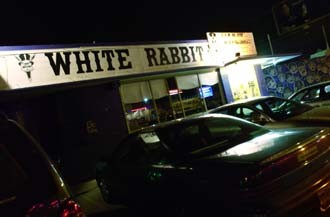| One of San Antonio's few high-profile rock clubs, White Rabbit, recently scaled back its music calendar, eliminating hardcore touring shows and reducing its local-band gigs. Photo by Mark Greenberg |
There is a famous old joke about the unique plight of growing up Mexican: "Mexico - so close to the United States, so far from God."
Along the same lines, aspiring musicians in San Antonio must sometimes feel the sting of being so close to Austin, yet so far from a vital music scene. Among other things, Contemporary Art Month offers a harsh reminder that the kind of deep-rooted, well-developed artistic community that is built around visual arts in this city simply doesn't exist for local music.
There are several reasons for this. For one thing, San Antonio's musical passions have long been Tejano and heavy metal, leaving scarce wiggle-room for bands interested in something left-of-center.
And, even though San Antonio has its share of colleges, it doesn't have the kind of strong college presence found in most music meccas. Like, for instance, Austin. The self-proclaimed "live music capital of the world" has always been problematic for San Antonio's club scene. It provides a range of musical options in proximity to San Antonio, but it also tends to smother this city's musical identity.
Touring indie-rock acts rarely fail to stop in Austin, and there is little motivation for them to play another show an hour away in San Antonio. There are exceptions, like Frank Black (who plays here so often he's practically a local act), but they are pretty rare. National shows provide Austin bands with plenty of opportunities to be openers on the bill, to develop some local momentum, and to make decent money. None of those possibilities exist on a regular basis in San Antonio. If you are a promising San Antonio band, you would be well advised to make the move up I-35 to Austin.
Juan Ramos, drummer for Sexto Sol and a talented visual artist, made that move in the mid-'90s with his old band Glorium. "Our band started here, and we moved to Austin because of the music scene," Ramos says. "We were doing alternative-rock music, or post-punk at the time, and there was just a bigger scene for that in Austin, there were more venues to play at, and - not that money was the most important thing - we were able to make more money there than we could ever make in San Antonio.
"Currently, that's still the case. Here in town, there aren't a lot of places to play, and not a lot of money to support what you're doing."
It says a lot about the relative potency of the art and music scenes in San Antonio that highly creative musicians like Ramos and Lloyd Walsh (bassist for the Exploding Sex Kittens) tend to get more attention for their visual work than for anything they do onstage.
"It's like two different circles," Ramos says. "The music that has thrived in San Antonio has been mainly Tejano music, mostly in the '80s and early '90s, and that whole circle doesn't cross over into a lot of the art world circles. Maybe people involved in the Tejano music industry aren't that aware of a lot of things that go on art-wise in the city."
The enduring strength of San Antonio's art community owes a lot to older artists who established markets for their work, cultivated the next generation, and helped build an organized art community. As Ramos points out, it's not as easy for veteran musicians to elevate young bands, particularly when gigs are scarce and club attendance is thin. "Older, more established artists can help younger artists more than an older musician can help a younger musician," Ramos says. "An older artist can introduce you to somebody who runs a gallery, and knows somebody else. That kind of networking is a little more helpful than with bands. With bands, unless you're not really concerned about the money, the bottom line is always going to be how the venue is going to make money off of you."
One of San Antonio's few high-profile rock clubs, White Rabbit, recently scaled back its music calendar, eliminating hardcore touring shows and reducing its local-band gigs. The club, long a bulletin-board target at Hogwild Records for its allegedly band-unfriendly booking policies, has morphed into something resembling a neighborhood sports bar, or - considering the degree of body piercings on the premises - maybe an xtreme-sports bar.
The challenge of putting together a band, coping with a frustrating club scene, and finding an audience for your music can seem intimidating, while choosing the visual-arts path means you can be a self-contained entity, ultimately dependent on galleries and museums, but still able to control your fate much more than local musicians. In Austin, young creative people tend to express themselves musically. In San Antonio, the visual-arts option makes more sense. As Ramos says: "You just have more freedom as an artist." •


